KVS TGT Math Mock Test - 9 - KVS PGT/TGT/PRT MCQ
30 Questions MCQ Test - KVS TGT Math Mock Test - 9
Direction: A word in capital letters is followed by four words. Choose the word that is most nearly opposite in meaning to the word given in capital letters.
SMOTHER
In which city is the iconic Madison Square Garden located?
In this questions, a number series is given with one term missing. Choose the correct alternative that will continue the same pattern and fill in the black spaces.
Q. 1, 2, 3, 6, 9, 18, (___), 54
Select the option in which the given figure is embedded (rotation is NOT allowed).
Which of the following is crucial time while accessing data on the disk?
To activate the previous cell in a pre-selected range, press
The process of converting analog signals into digital signals so that they can be processed by a receiving computer is referred to as:
Which of the following will not come under collaborative teaching-learning process ?
Which one of the following is not a function of a good textbook?
Two coins are tossed together. The probability of getting head on both the coins is
ABCD is a Parallelogram in which AB = 9.5cm and its perimeter is 30cm. Find the length of each side of the Parallelogram?
The width of each of five continuous classes in a frequency distribution is 5 and the lower class limit of the lowest class is 10. The upper class limit of the highest class is
Read the following text and answer the following questions on the basis of the same:
A small scale industry produces a certain boxes of candles in a day. Number of boxes prepared by each worked on a particular day was 2 more than thrice the number of workers working in the industry. The number of boxes produced in a particular day was 85.
Q. Represent the above equation in quadratic equation.
In the given figure, AB = AC, AD = AE = 5 cm and DC = 8 cm. Length of EB is______.
The lower limit of the modal class of the following data is:
The point (2, –3) belongs to quadrant _______________ :




















